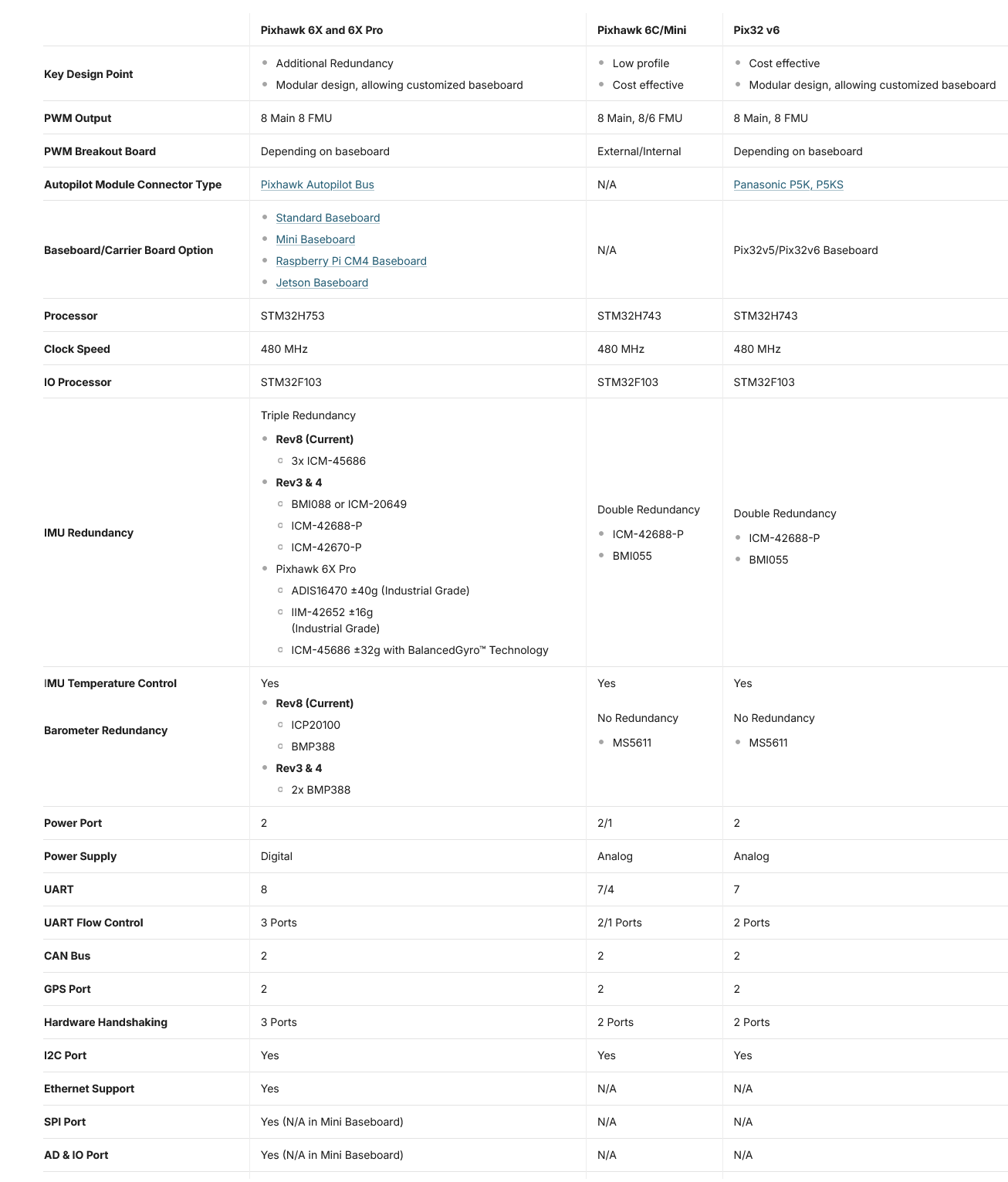Pix32v6 Flight Controller¶
Pix32v6 is a variant of the Holybro Pixhawk 6C. It is comprised of a separate flight controller and carrier board which are connected by a 100 pin connector. It is designed for those pilots who need a high power, flexible and customizable flight control system.

Where To Buy¶
The Pix32v6 autopilots are sold by Holybro
Features of Pixhawk6 Series¶
(click table below to expand)

UART Mapping¶
SERIAL0 -> USB
SERIAL1 -> UART7 (Telem1) RTS/CTS pins
SERIAL2 -> UART5 (Telem2) RTS/CTS pins
SERIAL3 -> USART1 (GPS1)
SERIAL4 -> UART8 (GPS2)
SERIAL5 -> USART2 (Telem3) RTS/CTS pins
SERIAL6 -> USART3 (USER)
SERIAL7 -> USB (can be used for SLCAN with protocol change)
All UARTs except UART4 have full DMA capability.
RC Input¶
The RCIN pin, which by default is mapped to a timer input, can be used for all ArduPilot supported receiver protocols, except CRSF/ELRS and SRXL2 which require a true UART connection. However, FPort, when connected in this manner, will only provide RC without telemetry.
To allow CRSF and embedded telemetry available in Fport, CRSF, and SRXL2 receivers, a full UART, such as SERIAL6 (UART3) would need to be used for receiver connections. Below are setups using Serial6.
SERIAL6_PROTOCOL should be set to “23”.
FPort would require SERIAL6_OPTIONS be set to “15”.
CRSF would require SERIAL6_OPTIONS be set to “0”.
SRXL2 would require SERIAL6_OPTIONS be set to “4” and connects only the TX pin.
Any UART can be used for RC system connections in ArduPilot also, and is compatible with all protocols except PPM. See Radio Control Systems for details.
PWM Output¶
The Pix32v6 supports up to 16 PWM outputs. All 16 outputs support all normal PWM output formats. All FMU outputs (marked “FMU PWM Output”) also support DShot.
The 8 FMU PWM outputs are in 4 groups:
PWM 1, 2, 3 and 4 in group1
PWM 5 and 6 in group2
PWM 7 and 8 in group3
FMU outputs within the same group need to use the same output rate and protocol. If any output in a group uses DShot then all channels in that group need to use DShot.
Battery Monitoring¶
The board has 2 dedicated power monitor ports with a 6 pin connector. The Pix32v6 uses analog power monitors on these ports.
BATT_MONITOR = 4
BATT_VOLT_PIN = 8
BATT_CURR_PIN = 4
BATT_VOLT_MULT = 18.182
BATT_AMP_PERVLT = 36.364
BATT2_VOLT_PIN = 5
BATT2_CURR_PIN = 14
BATT2_VOLT_MULT = 18.182
BATT2_AMP_PERVLT = 36.364
Compass¶
The Pix32v6 has a built-in compass. Due to potential interference, the autopilot is usually used with an external I2C compass as part of a GPS/Compass combination.
GPIOs¶
The 8 FMU PWM outputs can be used as GPIOs (relays, buttons, RPM etc). To use them you need to set the output’s SERVOx_FUNCTION to -1. See GPIOs page for more information.
The numbering of the GPIOs for PIN variables in ArduPilot is:
FMU pins:
FMU1 50
FMU2 51
FMU3 52
FMU4 53
FMU5 54
FMU6 55
FMU7 56
FMU8 57
Analog inputs¶
The Pix32v6 has an analog RSSI input pin:
Analog 3.3V RSSI input pin = 103
Connectors¶
Unless noted otherwise all connectors are JST GH
See Pix32v6 pinout
Loading Firmware¶
The board comes pre-installed with an ArduPilot compatible bootloader, allowing the loading of xxxxxx.apj firmware files with any ArduPilot compatible ground station.
Firmware for these boards can be found here in sub-folders labeled “Pixhawk6C”.